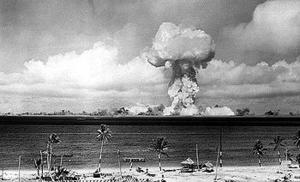Radiation risksIslanders’ radiation worries 60 years after Bikini Atoll atomic test
Sixty years ago, On 1 March 1954 the United States tested a 15-megaton hydrogen bomb – a thousand times more powerful than the bomb dropped on Hsroshima —- at Bikini Atoll, part of the Marshall Islands. The explosion vaporized one island, and exposed inhabitants on neighboring islands to radioactive fallout. The United States relocated many of the islanders and spent years – and more than $45 million – to clean up and decontaminate the islands, before allowing the relocated inhabitants to return. Many were forced to leave again, however, after they were found to be exposed to residual radiation. From 30 June 1946 to 18 August 1958, the United States conducted 67 atmospheric nuclear tests in the Marshall Islands.

Nuclear test at Bikini Atoll // Source: commons.wikimedia.org
On 1 March 1954 the United States tested a 15-megaton hydrogen bomb – a thousand times more powerful than the bomb dropped on Hsroshima —- at Bikini Atoll, part of the Marshall Islands. The explosion vaporized one island, and exposed inhabitants on neighboring islands to radioactive fallout. The United States relocated thousands of them to temporary shelters farther away from the test site, and for the following three years, at a cost of $45 million, cleaned up and decontaminated those atolls exposed to radiation.
In 1957 the relocated inhabitant were allowed to return to their homes.
Thirty years later, in 1985, scientists found out that the cleanup had not been as effective as initially thought, and that many of the inhabitants who returned were exposed to residual radiation.
Yahoo News reports that Bikini islanders have lived in exile since they were moved for the first weapons tests in 1946. In the early 1970s U.S. government scientists declared Bikini safe for resettlement, and some residents were allowed to return. They were removed again in 1978, however, after ingesting high levels of radiation from eating local foods grown on the former nuclear test site.
The United States has expressed regret about islanders’ exposure to high doses of radiation during the series of nuclear tests.
“While international scientists did study the effects of that accident on the human population unintentionally affected, the United States never intended for Marshallese to be hurt by the tests,” the U.S. embassy in Majuro says on its Web site.
During the period from 30 June 1946 to 18 August 1958, the United States conducted 67 atmospheric nuclear tests in the Marshall Islands: 43 at Enewetak Atoll, 23 at Bikini Atoll, and one approximately eighty-five miles from Enewetak. The most powerful of those tests was the 1 March 1954 “Bravo” shot, a 15-megaton device detonated at Bikini atoll.
From 1945 to 1988, the United States conducted a total of 930 nuclear tests with a combined yield estimated to be 174 megatons. Approximately 137 megatons of that total was detonated in the atmosphere. This means that while the number of tests conducted in the Marshall Islands represents about 14 percent of all U.S. tests, the yield of the tests in the Marshalls comprised nearly 80 percent of the atmospheric total detonated by the United States.
Despite the cleanup efforts, a 2012 UN report said the effects of those tests were long-lasting.
Special Rapporteur Calin Georgescu, in his report to the UN Human Rights Council, said that “near-irreversible environmental contamination” had led to the loss of livelihoods and many people continued to experience “indefinite displacement.”
The report called for the United States to provide extra compensation to settle claims by nuclear-affected Marshall Islanders and end a “legacy of distrust.”
Yahoo News notes that the Nuclear Claims Tribunal awarded more than $2 billion in personal injury and land damage claims arising from the nuclear tests, but stopped paying after a U.S.-provided $150 million compensation fund was exhausted.
